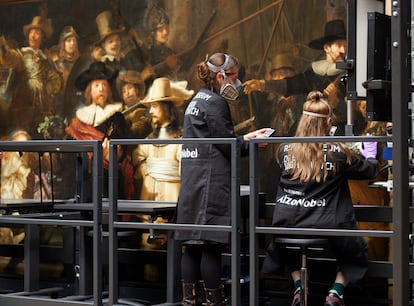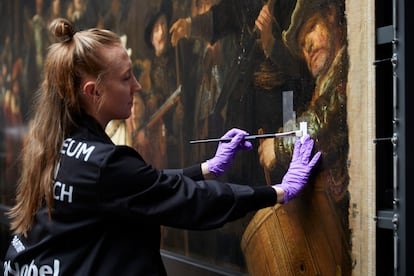Five years after the Rijksmuseum in Amsterdam embarked on “operation The night watchthe largest investigation carried out on the famous painting painted by Rembrandt in 1642, the time has come to remove the varnish from the oil painting. Starting this Tuesday, a team of eight conservators will gradually clean a cloth that measures 3.79 meters long by 4.36 meters high. They will do it with a special type of fabric to avoid damage to the canvas. The restoration, which will preserve the painting for the future, can be followed live, as the work will be carried out in public view. The work is in an open-top glass case, installed in the museum in 2019, which has protected it from microclimates harmful to the pigments during the previous research phase.
To remove the layers of varnish, applied between 1975 and 1976, conservators will place the fabric, prepared with a solvent, on the surface of the canvas for “a short and limited time,” according to the Rijksmuseum. The varnish becomes soluble on contact and is absorbed by the fabric. Next, any remains will be removed with cotton swabs and the help of a microscope. “Removing the varnish will reveal the eventful history of The night watch and it will be a unique experience for the public to be able to follow the process from so close,” says Taco Dibbits, its director.
In front of the painting, which has a special scaffolding so that the restorers can reach all its corners, Anna Krekeler, a paintings conservator, shows the fabric with which they will clean it. “It is organic, without chemicals and we have already tested it on other paintings in the museum.” Removing the varnish “will take several years and then a new layer will be put on.” Before, anyway, “we will restore the parts that are damaged, something for which there was no time in the seventies.” When everything is ready, “we hope that The night watch has recovered its original tone.” Dibbits notes: “Now we will see the naked truth of the canvas. In previous restorations, the figures, which were the focus of attention, were not usually overlooked. We will then see the nuances of the background.”
The night watch It is one of the main complaints of the museum, which did not want to take it down from the gallery of honor during long-term work. The solution consisted of placing it without a frame—even so, it weighs 170 kilos, according to the museum—in that kind of showcase that leaves the work seven meters from the viewer. In return, you can follow live the work of conservators, researchers, computer scientists and photographers, who have been discovering the secrets of The military company of Captain Frans Banninck Cocq and Lieutenant Willem van Ruytenburgits original title. The round of the civic militia portrayed by Rembrandt took place during the day, but the layers of varnish, darkened over time, ended up giving the painting a popular nocturnality.
During these five years, more than 12,500 high-precision photographs of the canvas have been taken. Fluorescent rays have been applied, which allow reaching the oil layers without damaging them; spectroscopy and microscopy techniques. With the help of artificial intelligence (AI), on the other hand, the painting has been reconstructed, since four portions were cut in 1715. It did not fit in the room of the Amsterdam City Hall that corresponded to it and that was the strange way to fit it. The missing pieces have not been found, but it is known that to the left of the painting there were three other characters thanks to a copy made before the snip and attributed to the Dutch artist Gerrit Lundens. In June 2021, an image of the complete canvas was presented based on aligning more than 10,000 elements of information obtained from both paintings. It was the first time the entire work had been seen in 300 years, and the result was an image “geometrically consistent with the size and position of the three cut figures,” Robert Erdmann, a cultural heritage specialist at the museum, explained to the press. .
The investigations continued and in December 2021 the Rijksmuseum revealed that the painting had an initial sketch under the final work. It is the origin of the composition and amounted to “a chalk map of the work,” said Peter Roelofs, head of painting and sculpture at the Rijksmuseum. They also saw that some decorative feathers belonging to a member of the militia had disappeared in the final version. And a pigment with arsenic was found, little associated with the painter. In January 2022, the Dutch art gallery published a photograph of The night watch composed of 8,439 images, united again with the help of AI. Thanks to a viewfinder, it could be magnified in front of the computer to see all the details without distortions.

In December 2023, researchers made another discovery. The master of the Golden Age had used lead in a layer of impregnation located below the one applied to prepare the work. It was the first time it had been observed over the entire surface of the canvas and was made possible thanks to the combination of X-ray and 3D imaging techniques. Lead creates tiny protuberances that can fall off, damaging the paint and that must be taken into account for conservation. This study was published in the American journal Science Advances, and Fréderique Broers, scientific researcher at the museum and main author of the work, told this newspaper: “The fall of the protuberances has already caused small holes in the fabric,” which are imperceptible to the human eye. However, this type of analysis can help preserve the fabric.
Less than a year later, in July 2024, researchers verified that Rembrandt had mixed arsenic sulfide pigments in his work. In this way, he created the illusion that there was a gold thread in the embroidery of Lieutenant Willem van Ruytenburg’s doublet. It is the figure dressed in yellow in the center of the painting. The discovery, in which Broers herself participated, expands the painter’s palette and also the range of materials used in the 17th century in Amsterdam.

